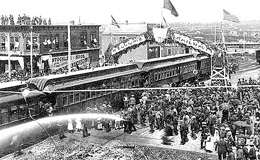On June 22, 1891, American and Canadian dignitaries and thousands of onlookers gather in New Whatcom (later Bellingham) to celebrate the arrival of the first regularly-scheduled Canadian Pacific train. Mischief erupts when two local fire companies, placed on either side of the rail tracks and instructed to aim their hoses to form a welcoming arch of water for the train to pass under, aim their hoses at each other instead.
A Big Day
It was a big day in New Whatcom. The Bellingham Bay and British Columbia Railroad -- known as the B.B. & B.C. -- had been formed eight years earlier in 1883 to build a line between Vancouver, British Columbia, and Whatcom (then one of four independent towns on Bellingham Bay in Whatcom County that would gradually consolidate to form Bellingham). Construction began in 1884, stopped for a few years, but eventually was completed to the border town of Sumas on March 1, 1891. Several weeks later the Canadian Pacific Railway likewise reached Sumas from the other side of the border.
New Whatcom -- as Whatcom was renamed upon merging that year with neighboring Sehome -- rejoiced. The new rail line opened the door for travel east and, more significantly, promised to open the door for more business in New Whatcom. Six thousand jubilant souls came together at the Holly Street depot on June 22, 1891, to celebrate the arrival of the first regularly scheduled Canadian Pacific train. A large arch of welcome was built across the tracks at Holly Street and Railroad Avenue, adorned with an American flag on top of each of the two supporting towers and a Canadian flag atop the center of the arch.
The Great Water Fight
The men of the separate Whatcom and Sehome volunteer fire companies -- which had not merged when their towns did -- were instructed to line up with their water hoses on opposite sides of the tracks and form a welcoming arch of water for the train to pass under when it arrived. Pressurized fire hoses were new and exciting in New Whatcom in 1891, and the idea was not only to create a novel welcome but also to show off the powerful pressure provided by the water system. The idea wildly succeeded on both counts.
At 1 p.m. the train rolled into view. Bands burst into song, the crowd cheered, mill whistles shrieked, and jollity reigned. As the train approached, someone gave the signal for the water display. The Whatcom company got pressure first. Seeing the Sehome side defenseless, they gave their rivals a friendly blast of H2O. The Sehome company was quick to respond with its own blast at the Whatcom boys as soon as it got water pressure. Soon it was an all-out water fight. The hosers forgot all about aiming to form an arch. They aimed at each other. When the train passed by, they aimed at it too. Some of its windows were knocked out by the force of the water. Other windows on the train were already open, and most of its 200 passengers were drenched. Some in the crowd were also soaked.
"All agreed that it was a damp bad reception," wryly remarked Lottie Roeder Roth in her History of Whatcom County 35 years later. The Americans apologized profusely; the Canadians were gracious, and the ceremonies happily continued with an elaborate reception at the Purdy Opera House.
But it did not end well. During the festivities a few young rowdies, fueled by whiskey courage, noted that the Canadian flag on the arch was somewhat higher than the American flags. They climbed the arch, ostensibly to lower Canada's flag to the American flags' level, but instead ripped it down and trampled it. The Canadians were understandably livid. Hot talk and an investigation by the New Whatcom City Council followed, but it eventually faded away. It was a lamentable ending to an otherwise big day in Bellingham's early history.

